Google Nexus 7 and Android 4.1 - Mini Review
by Brian Klug on June 28, 2012 3:25 AM EST- Posted in
- Tablets
- Smartphones
- Mobile
- Nexus 7
- Android 4.1
The fact that Google launched a 7" tablet by ASUS isn't a particularly huge surprise, given that ASUS showed off the Eee Pad Memo back at CES. The story goes that Google liked that particular tablet so much, it became slotted in to become the first Nexus tablet, much to Samsung's chagrin. While there have been other "Google Experience" tablets before (for example the Motorola Xoom), there hasn't been a bona-fide Nexus tablet yet, and especially not one at an aggressive price point like this. For that, enter the Nexus 7.
The Nexus 7 comes with Android 4.1 Jelly Bean installed, which we're going over on the next page. It brings improvements to UI performance through Android
Most important is the Nexus 7's price point, which up until now has largely been one of the main issues with Android tablets - price. It's fair to say that the Kindle Fire has done a good job proving that there is indeed a market for lower cost, simplified tablets at an aggressive price point, and the Nexus 7 is Google's answer. Pricing for the Nexus 7 is $199 for the 8 GB model, and $249 for the 16 GB model. There aren't any other differences between the two, nor is there a model with cellular connectivity – this is strictly WiFi only, but again, this is a tablet for the masses without the carrier hurdle.
| ASUS Tablet Specification Comparison | ||||||
| ASUS Transformer Pad Infinity | ASUS Transformer Pad 300 Series | ASUS Eee Pad Transformer Prime | ASUS Nexus 7 | |||
| Dimensions | 263 x 180.6 x 8.4mm | 263 x 180.8 x 9.9mm | 263 x 180.8 x 8.3mm | 198.5 x 120 x 10.45mm | ||
| Chassis | Aluminum + Plastic RF Strip | Plastic | Aluminum | Plastic + Rubber back | ||
| Display | 10.1-inch 1920 x 1200 Super IPS+ | 10.1-inch 1280 x 800 IPS | 10.1-inch 1280 x 800 Super IPS+ | 7" 1280 x 800 IPS | ||
| Weight | 594g | 635g | 586g | 340 g | ||
| Processor |
1.6GHz NVIDIA Tegra 3 (T33 - 4 x Cortex A9) |
NVIDIA Tegra 3 (T30L - 4 x Cortex A9) |
1.3GHz NVIDIA Tegra 3 (T30 - 4 x Cortex A9) | 1.3 GHz NVIDIA Tegra 3 (T30L - 4 x Cortex A9) | ||
| Memory | 1GB DDR3-1600 | 1GB | 1GB | 1 GB | ||
| Storage | 32/64GB + microSD slot | 16GB/32GB + microSD slot | 32GB/64GB + microSD slot | 8 GB / 16 GB | ||
| Battery | 25Whr | 22Whr | 25Whr | 16 Whr | ||
| Pricing | $499/$599 | $379/$399 | $499/$599 | $199/$249 | ||
When you look at the above specs, it seems puzzling that ASUS was able to get the price down to $199 so effectively. Getting to that lower price point is easier with a few things - physically smaller device and display, exclusion of full size USB or other ports (there's only microUSB), no rear facing camera, and good commodity component sourcing. The added plus is that if you run 1280 x 800 at a smaller size, out comes a pretty high DPI panel at the same time. Other than that though, you end up getting a device which is actually very impressive otherwise, with a quad core SoC and attractive form factor.
I like starting with physical impressions since it's the easy route, and so much of one's experience with a given device depends on that ever important in-hand feel. ASUS has taken an excellent direction here and made the back construction of the Nexus 7 a great textured rubber material. There's Nexus embossed in the top, and ASUS proudly at the bottom. Below that is a small notch for the speaker, which goes pretty loud.
The power / lock and standby buttons get placed on the top right corner, and both microUSB and the headphone jack are located at the very bottom. There are also some pogo pins on the bottom left, just like the Galaxy Nexus. No doubt these will work with some future unannounced accessories.
The Nexus 7's construction is downright impressive. While I haven't been doing regular tablet reviews (that has become Anand's domain largely), I have handled a number of recent tablets big and small, and some feel downright cheap to me thanks to the back plastic. I would not have guessed that the Nexus 7 is a $199 device based on how it feels. There's no flex or creaking at all, it feels absolutely rigid. The tradeoff is that the Nexus 7 is slightly thicker than some other devices, at almost 10.5 mm (compared to 8.5 or 9), but that larger thickness also permits a bigger edge bevel radius. I feel that 7" is an ideal tablet form factor for me personally.
So the next logical question is what performance is like on the Nexus 7. I asked around, did my own digging, and wound up confirming that what's inside the Nexus 7 is indeed a Tegra T30L SoC. This is a lower leakage / lower binning T30 that no doubt is offered at a cost advantage to ASUS - I was expecting a T30L inside and am wholly unsurprised to see one. The only difference is that CPU clocks are 1.15 GHz for all four cores at 100%, or 1.3 GHz on a single core. The GPU clock is also slightly lower at 416 MHz. The Nexus 7 also ships with 1 GB of RAM, and I'm pretty certain this is DDR2 at 500 MHz based on what I see from the digging I've done.
I've borrowed Anand's TF700T review graphs and added data from the Nexus 7 that I hastily ran this afternoon. The results are in line with my expectations for T30L and other devices with T30L inside that we've already benchmarked.
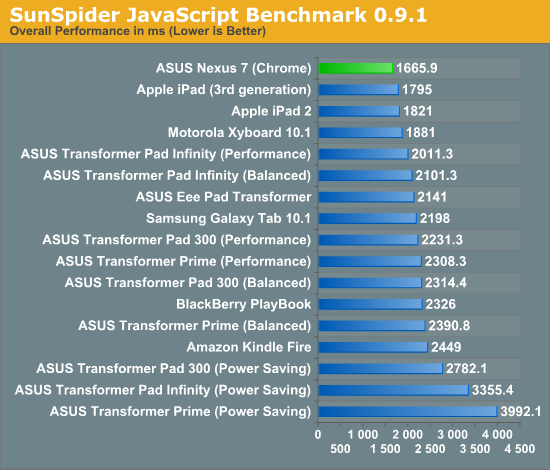
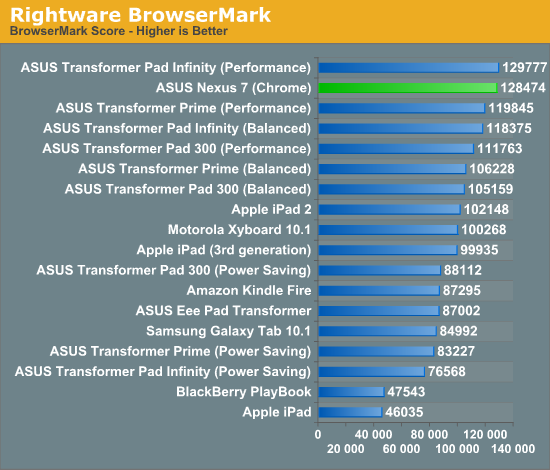
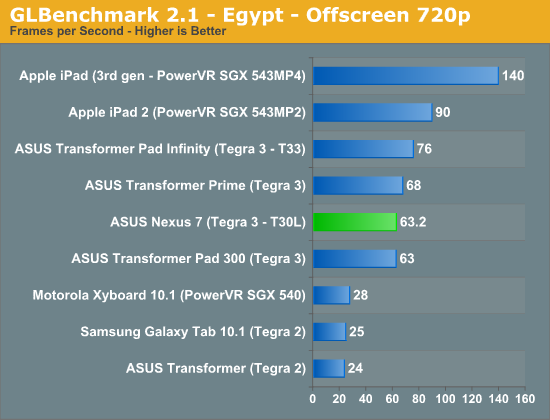
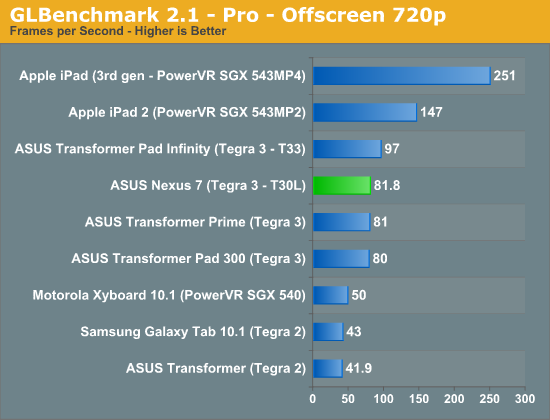
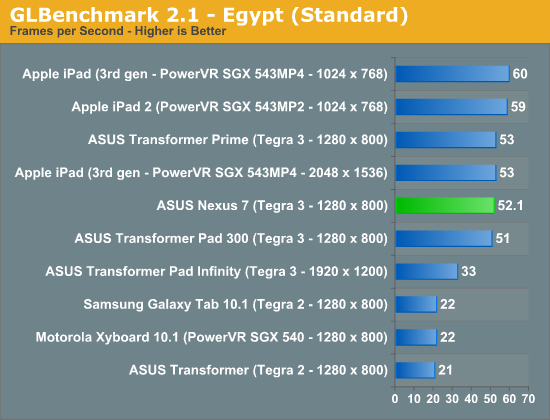
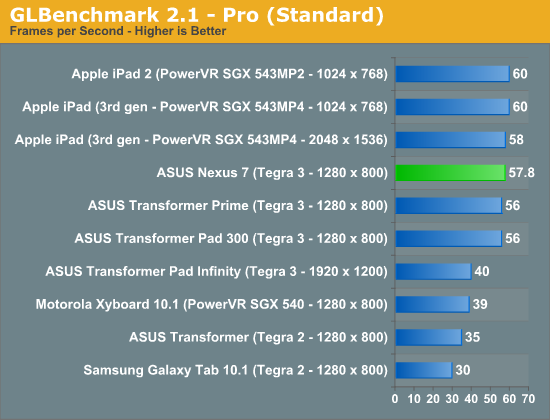
The Transformer Pad 300 uses the same T30L SoC as the Nexus 7, so it isn't surprising to see the two post numbers very close to each other in so many places.
I should note on the browser synthetics that we're also talking about Chrome here, not "Browser" as the Nexus 7 is the first Android device to ship with Chrome as the default browser. In this case, that means there's no "browser" to be found anywhere on the device. You can still install Flash from the Play Store, it just doesn't do anything anymore.
Speaking of digging, I sent Francois Simond (@supercurio) a voodoo report from the Nexus 7, and he has graciously done a component analysis just like we've done with other devices in the past. There aren't too many surprises inside. WiFi and Bluetooth is courtesy the ever-ubiquitous BCM4330 module, which no doubt has gotten cheaper now that BCM4334 is out. The front facing camera is a Aptina MI 1040 1.3MP CMOS with 3.6µm pixels and 1/3" optical format. NFC comes courtesy a new NXP PN65 controller which is best I can tell a PN544 with embedded SE (secure element).
The next question is what that display looks like. We've seen other lower cost tablets ship before, but usually the first thing that gets skimped on is the display. In the case of the Nexus 7, ASUS notes that the panel is an LED backlit IPS panel with 10 point multitouch and 400 nits maximum brightness. Resolution is of course WXGA (1280 x 800) at 7". If you do the math out, that's a pretty high PPI, and in person it looks great - I can't see pixels unless I look very closely.
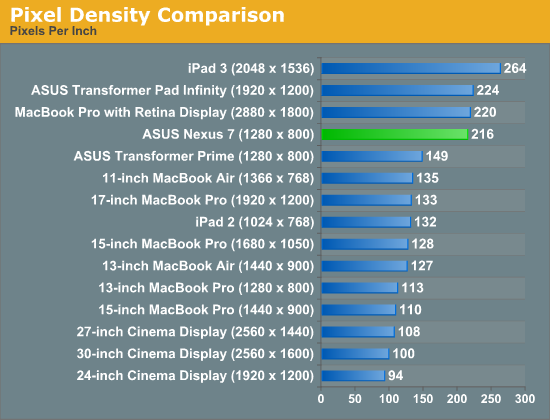
Since I expected having to do something of a tablet review on this trip to Google I/O, I brought along my i1D2 colorimeter. I took measurements on the Nexus 7 using my normal workflow – a combination of Francois' Voodoo Screen Test Patterns and Color HCFR.
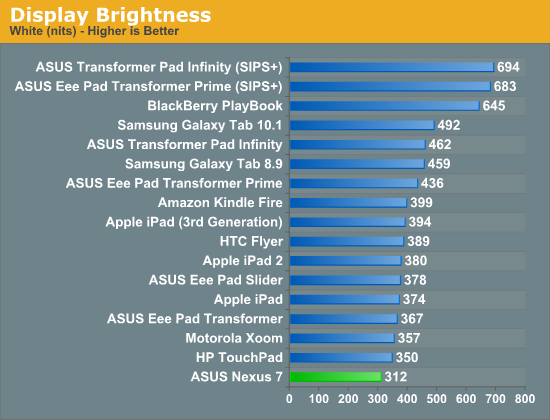
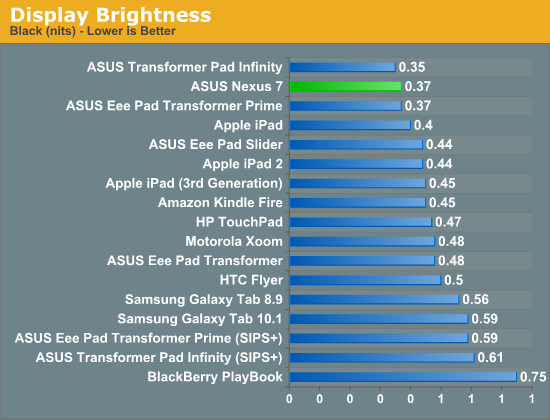

Brightness falls a bit short of the advertised 400 nits at just 312 nits. I'm actually not sure whether there's some of Nvidia's Prism power saving tech going on here (there's no toggle anywhere for it), but that's as bright as I could get the Nexus 7 to go. Contrast on the other hand is pretty good, at 850, and blacks are very good at 0.37 nits.
The rest of the display metrics are a bit interesting, with color temperature hovering around 5500K which is a bit warm for my taste, and gamma isn't flat over the grey scale either. What's really curious to me is that the greens seem undersaturated (the larger triangle is sRGB), which was my first impression on seeing the Nexus 7 while installing some apps from Google Play (which has lots of green). Again I'm not sure whether this is some power saving Prism technique at work here.
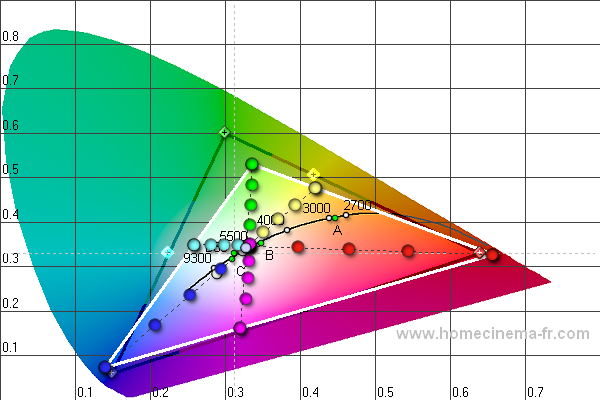
I feel like those metrics could mislead you into thinking the display is bad, on the contrary it's obvious this is an IPS panel based on the viewing angles, which are superb off axis in the horizontal and vertical. You just can't get away with putting a TN in a tablet because of how bad viewing angles are immediately visible on a big surface device like a tablet. The Nexus 7's IPS display is very contrasty and has a high enough PPI that I'm not wishing for higher resolution.
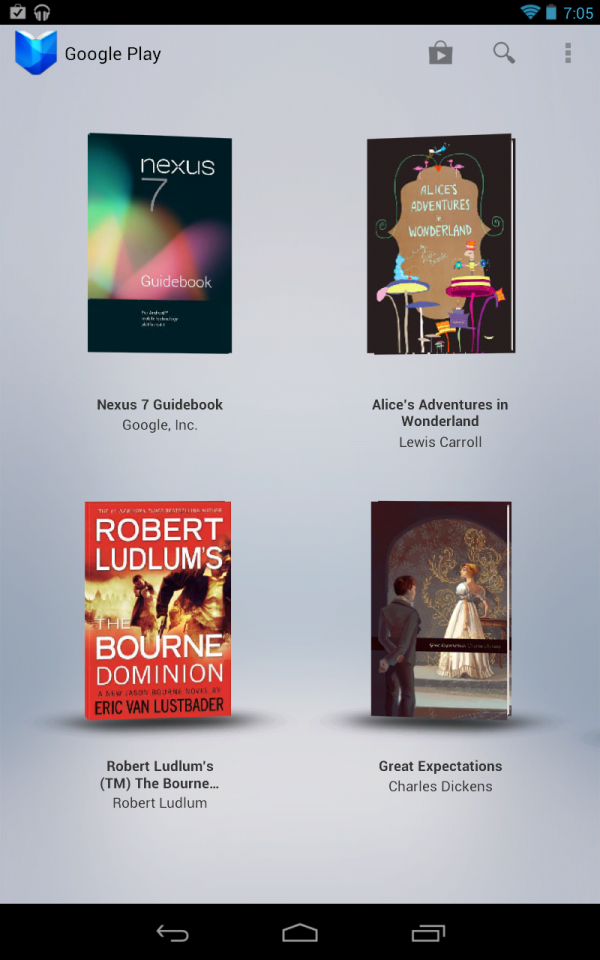
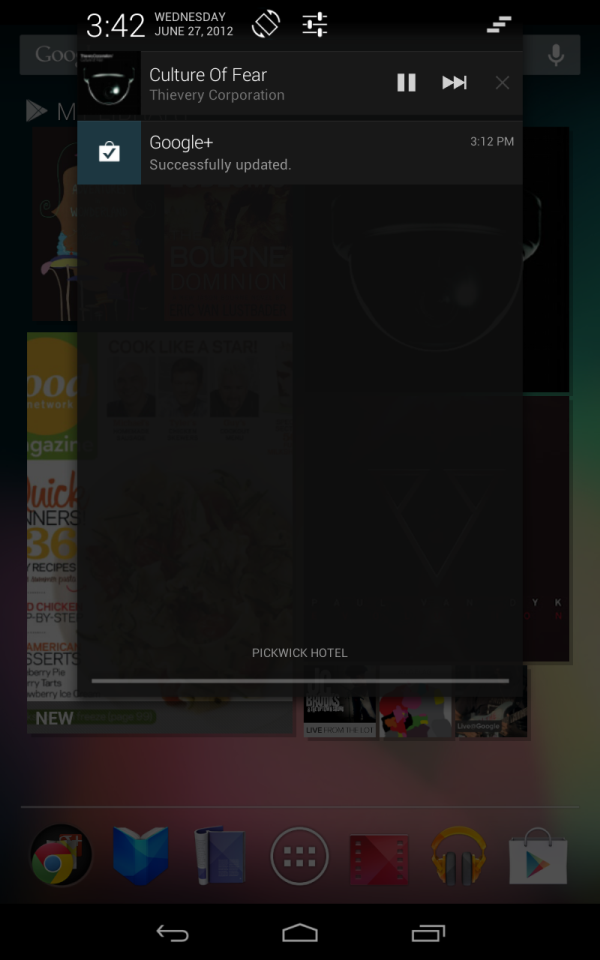
Left - some bundled Google Play books, Right: Notice the new rotation lock toggle on the notification shade, and new style
Google is also doing something interesting with the Nexus 7 by bundling a $25 Play Store credit which pops up in your account after signing into your Google account for the first time. The strategy seems pretty obvious here - get Nexus 7 buyers to at least check out the Play stores. In addition, they've preloaded a number of books and videos which should bait users into at least checking out the respective Google Play applications.
Honestly I think ASUS and Google have really done an excellent job here with the Nexus 7. The combination of a quad core SoC, IPS panel, solid construction, and the latest version of Android all for such a killer price point pretty much make it hard to really find any faults. Sure, it'd be useful to have a full size USB host port, microSD slot (though no Nexus has shipped with one since Nexus S), 5 GHz WiFi (Nexus 7 is 2.4 GHz only), or cellular, but the tablet wouldn't be $199 anymore. I also really feel like the 7 inch diagonal form factor is an ideal one, and the Nexus 7 is quickly growing on me.
Update: I've had many emails and questions about whether USB-OTG (On The Go) is supported on the Nexus 7, and didn't touch on it when I originally hit publish becuause I wasn't entirely sure. I've now confirmed that USB-OTG is supported on the Nexus 7, and works on the current Android 4.1 non-final build that has been sampled. That's encouraging, and I'll test it myself when I get home and to my miniUSB OTG adapter.
Update 2: I've asked for further clarification about what USB-OTG functionality is supported. Using a mouse and keyboard will be supported, and I saw Google using an ethernet to USB adapter over USB-OTG as well. Unfortunately I found out that mounting USB storage will not be supported natively. In addition MHL is not supported.
Now, what about Android 4.1?


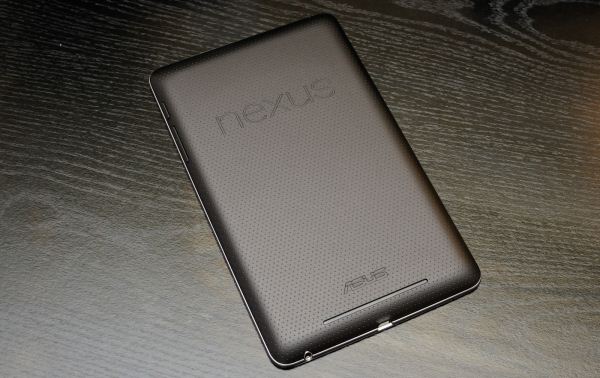







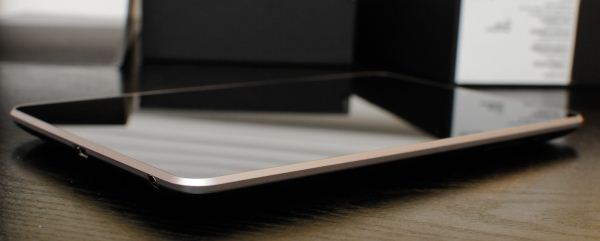
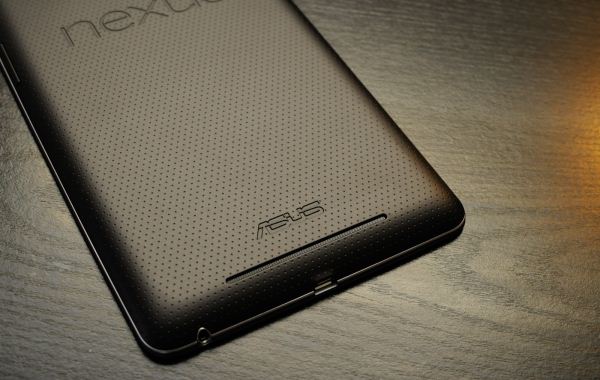






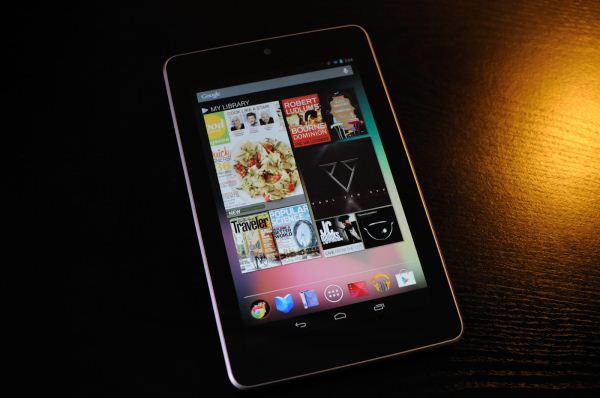








188 Comments
View All Comments
Commodus - Wednesday, July 4, 2012 - link
It's the nature of the file system.To get one large, contiguous piece of storage, Google literally can't have an SD card slot -- the moment it does, you end up with the usual splintered Android storage pool. 3GB here, 8GB there, but you can't pool it all or in some cases write to all of it. This is one of the core reasons why Apple doesn't use SD cards: it's hard to pitch an iPhone as the natural companion for iTunes if you can't actually fit 64GB of content (minus the OS, anyways) into 64GB of space.
As for the "toys and gimmicks" myth, ask corporations whether they're seeing more uptake of iOS devices or Android gear. More cross-pollination between parts of the OS would be great... but do you know what's also great? Having a higher-quality app ecosystem and device security. While you're bemoaning theoreticals, iOS users are actually getting things done. Getting real, large-scale corporate deployments while the Galaxy Tabs and Xyboards collect dust at Best Buy.
Android is potentially more powerful, but the decidedly worse-off development tools, a lax Google attitude towards taking down malware/knock-off/scam apps and Google's open hostility towards tablet-only apps (Andy Rubin has stated he doesn't want there to be such a thing) leave a lot of that potential wasted. Flipboard has said there are no plans, ever, for optimizing its app for Android tablets, as an example. Twitter's official app has no Android tablet optimization. You can't say you're getting more done on an Android tablet if developers are actively avoiding contact.
gatorproof - Thursday, July 5, 2012 - link
I FOUND THIS, "that the "external" in "external storage" is there for historical reasons, but refer to the shared storage of the device, internal or external, and not only to sd cards.From the dev site: «Every Android-compatible device supports a shared "external storage" that you can be used to save files. This can be a removable storage media (such as an SD card) or an internal (non-removable) storage.»"
Now this is from an attendee of the Google I/O. "READ_EXTERNAL_STORAGE permission. This is a new permission that will be required in a future release for apps that want to read the contents of the SD card. Up to now, anybody could read the SD card. It's not enforced in JellyBean unless you turn on a special developer option. Google strongly encourages all developers that read from the SD card to include this permission now" which sounds to a lay person like me, that Devs. can write in permission for an app to be allowed to be transferred to an app like "Apps2SD? I have not found many apps since Gingerbread and Honeycomb on to ICS that allow app storage to SD. I used it all the time in Elcair and Froyo.
Mr M S P, please understand, I am not trying to pass myself off as a coder or even a good Typist. But do these top paragraphs suggest that there can, with hitting the high notes, and crossing the T~s and dotting the I~s and using a micro USB to SD adapter, suggest to you that external is possible in JB?
ol1bit - Friday, July 13, 2012 - link
Looks like a killer $199 tablet. All the cheap crap was just put on notice.Heck, I I didn't have the Transformer Prime already, i'd be getting it!
Lucian Armasu - Friday, July 13, 2012 - link
Is there a full review coming? I would've expected you put out one by now.IBM650 - Sunday, July 15, 2012 - link
Bad slow wifi is a buck a minute (approx). And plugging crap into a micro usb is asking for trouble. My Nook Color has a wonderful IPS tablet, boots off the sd, and works great. I would have gotten the Nexus 7 but it is locked into the cloud.nomadh - Monday, July 23, 2012 - link
So I guess we should assume that the power usage steaming media from the cloud through a radio is exactly the same as off its local storage. Wifi is bad enough but when it gets to 3g or even 4g the cloud becomes just a joke for content. Add in limited availability problems and google just totally misses the point of their own devices.robbbzilla - Thursday, August 16, 2012 - link
I do not care if they sold it for $99 people would still complain and of it had the SD expansion then something else and on and on. Really just consider the device to cost $250.0 and stop complaining. Sure I want more storage and I want better speakers and I want but if you are really honest and have used it Google has done an amazing job.I can't believe how good this little tab is. Love the quad core and screen and for me those two make up for any minor problems. Plus giving you $25 worth of content they are practically selling these at cost.
Finally an alternative to the Ipad!!! Might I say it in some ways is better and costs a fraction of the iPad. For most people this device will do 80-90% of your computing needs. Also regardless of comparisons it is a really good device all on its own. It feels good, looks good, performs snappy and is a pleasure to use. I like the Google play interface and choicenof amazon market as well instead of just Apple store.
So if lack of expansion memory, a back camera, flash, and stereo speakers and lack of ports is going to stop you but you would still buy and Ipswich with the same restrictions at a higher price and not complain? Flash is over on mobile not because of apple or Android but because of Adobe. So it is on the way out. Storage issues can be worked around, lack of HDMI and no expansion slot is all I hear about but what device selling at $200 has those things? For what you get for the price is really a good deal and if google wants to promote thier services I see no problems as I am left to decide for myself.
Please go and try a nexus 7 before you complain.
sumwand - Saturday, August 18, 2012 - link
could we plug USB Modem (either GSM or CDMA) for wireless connectivity via GSM or CDMA on this Galaxy Nexus 7?